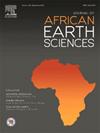Late Cretaceous-Paleogene tectonic event in the Tunisian foreland basins: Insights from unconformities and basin inversion
IF 2.2
4区 地球科学
Q2 GEOSCIENCES, MULTIDISCIPLINARY
引用次数: 0
Abstract
In this study, a comprehensive analysis was conducted on numerous sites within the Tunisian domains that exhibited early Atlasic inversion. The objective of this study is to evaluate and quantify this controversial compressive deformation period and conclude whether it is a local tectonic event or a regional compressional phase. Indeed, the geodynamic evolution of the Tunisian platform can be divided into major periods separated by a transitional period during the late Cretaceous. The first period was characterized by extensional movements associated with rifting phases that created several basins in a passive margin sedimentary environment. The second period was a compressive tectonic activity that occurred during the Cenozoic and resulted in major tectonic inversions.
This study examined ten distinct compressive structures, encompassing seismic line interpretation in the eastern Tunisian platforms, field outcrop maps and cross-sections, and the characterization of sedimentary hiatus. The results of the study demonstrated that during the Late Cretaceous-Eocene period, compressional structures were identified in the Golf of Hammamet, the Kairouan plains, the Golf of Gabes, and the central and meridional Atlas domains. These compressional structures have accumulated approximately 7.5 km of shortening and have exhibited a NE-SW decreasing deformation gradient from the Gulf of Hammamet to the Atlasic southern domain. Therefore, as a consequence of the cumulative shortening value, the large-scale sedimentary hiatus and the widespread deformation that was observed, it can be concluded that the Late Cretaceous-Eocene period corresponds to a confirmed compressional phase. This phase has inverted the sedimentary basins and triggered the creation of the Atlas orogen.
突尼斯前陆盆地晚白垩世-古近纪构造事件:来自不整合面和盆地反演的启示
在这项研究中,对突尼斯域内表现出早期大西洋反转的许多地点进行了全面分析。本研究的目的是评价和量化这一有争议的压缩变形期,并得出它是局部构造事件还是区域挤压期的结论。事实上,突尼斯地台的地球动力学演化可以划分为几个主要时期,以晚白垩纪的一个过渡时期为间隔。第一期的特征是与裂谷期相关的伸展运动,在被动边缘沉积环境中形成了几个盆地。第二个时期是发生在新生代的挤压构造活动,导致了主要的构造反转。本研究考察了10个不同的压缩构造,包括突尼斯东部台地的地震线解释、野外露头图和剖面,以及沉积间断的特征。研究结果表明,晚白垩世—始新世期间,在Hammamet的Golf、Kairouan平原、Gabes的Golf以及Atlas的中央和经向构造域中均存在挤压构造。这些挤压构造累积了约7.5 km的缩短,从哈马迈特湾到大西洋南域呈现北东-南西递减的变形梯度。因此,根据累积缩短值、观测到的大规模沉积间断和广泛的变形,可以得出结论,晚白垩世-始新世期对应于一个确定的挤压期。这一阶段翻转了沉积盆地,引发了阿特拉斯造山带的形成。
本文章由计算机程序翻译,如有差异,请以英文原文为准。
求助全文
约1分钟内获得全文
求助全文
来源期刊

Journal of African Earth Sciences
地学-地球科学综合
CiteScore
4.70
自引率
4.30%
发文量
240
审稿时长
12 months
期刊介绍:
The Journal of African Earth Sciences sees itself as the prime geological journal for all aspects of the Earth Sciences about the African plate. Papers dealing with peripheral areas are welcome if they demonstrate a tight link with Africa.
The Journal publishes high quality, peer-reviewed scientific papers. It is devoted primarily to research papers but short communications relating to new developments of broad interest, reviews and book reviews will also be considered. Papers must have international appeal and should present work of more regional than local significance and dealing with well identified and justified scientific questions. Specialised technical papers, analytical or exploration reports must be avoided. Papers on applied geology should preferably be linked to such core disciplines and must be addressed to a more general geoscientific audience.
 求助内容:
求助内容: 应助结果提醒方式:
应助结果提醒方式:


